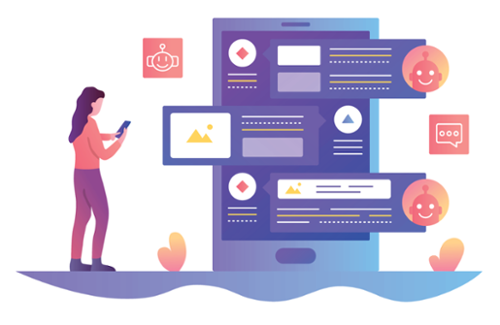
- There are many frameworks available to start developing your chatbot solution, for example, Google’s Dialogflow, Amazon Alexa, or Bot Framework from Microsoft. The benefits of using any one of these are undeniable: you can stand up a minimum viable product quickly. Without having prior AI knowledge, you can design the chatbot to fit your domain and integrate it with other services you already use. Some of them even have free offerings with sufficient capabilities to test your ideas, without investing a lot of time and cost.
After selecting the chatbot framework, the next critical step in building a chatbot is designing the conversational user interface (CUI) that delights your users. CUI as a distinct user experience channel is becoming prominent due to two trends:
Evolution of user interface and user experience technologies from browsers and search engines to smartphones delivering a richer and more personalized user experience.
Progression in consumer experience marked by user interactions that have evolved and co-mingled with storefront, catalog, agent, and online self-service channels.
Process Automation
We incorporated chatbots into our product strategy to improve operational efficiency in health system access centers through administrative process automation. Our chatbot integration automates the task of finding clinically appropriate providers and manages bookings, taking into account health system business rules and patient preferences. We maintain comprehensive information about providers such as contact information and location and share that information with patients when they interact with the chatbot. The chatbot channel is integrated into our clients digital experience. The chatbot shifts demand from access center agents for automatable tasks around provider matching and booking to the chatbot self-service channel.
Conversational User Experience Framework
You can realize the promise of a delightful user experience by adopting the Conversational User Experience framework which consists of the following key components – mission, personality, prioritized list of capabilities, and conversation flow.
There are four phases in the flow design— Welcome or Greeting Phase, Intent/Task Discovery Phase, Task Resolution Phase, and Session Conclusion Phase. The Intent/Task Discovery Phase is the most critical and important phase of the flow as this is where the intent takes place. The user task is resolved and chatbot ends the session after confirming the user has no further tasks.
By using the Conversational User Experience framework, you’ll be able to deliver a rich, personalized, and self-service experience for your users. Check out the first two blogs in the series to learn how your organization can leverage chatbots to meet consumer expectations and the guiding principles to follow for chatbot integration.
by Nausheen Moulana, on January 31, 2019
The original version of this page was published at: https://www.kyruus.com/blog/a-series-on-chatbots-using-chatbots-to-deliver-self-service-access-to-care
Kyruus delivers proven provider search, scheduling, and data management solutions that help health systems match patients with the right providers across multiple points of access.
In a recent MedCity News article, I shared that growing consumer demands for convenience and digital self-service have created opportunities for health systems to accelerate innovation ...read more
Consumers want convenience, flexibility, and seamless digital access that includes self-service tools to help them confidently search for, select, and schedule care on their own terms. Healthcare ...read more
Today's consumer is accustomed to doing everything online—and its no shock that this preference carries over into how they find and book care, turning to digital channels ...read more
Prior to this year, the majority of healthcare consumers had little experience with virtual care. Now, just six months later, most health systems are utilizing virtual care offerings ...read more

Connect Patients to Care Faster With HIPAA-Compliant Maps
A Feature Rich Alternative to Google Maps